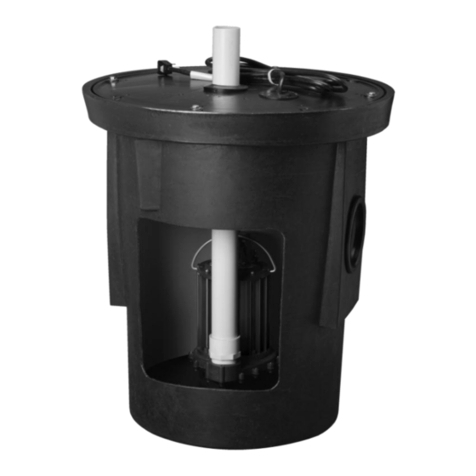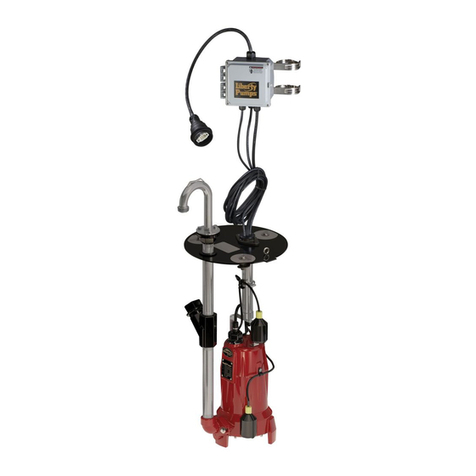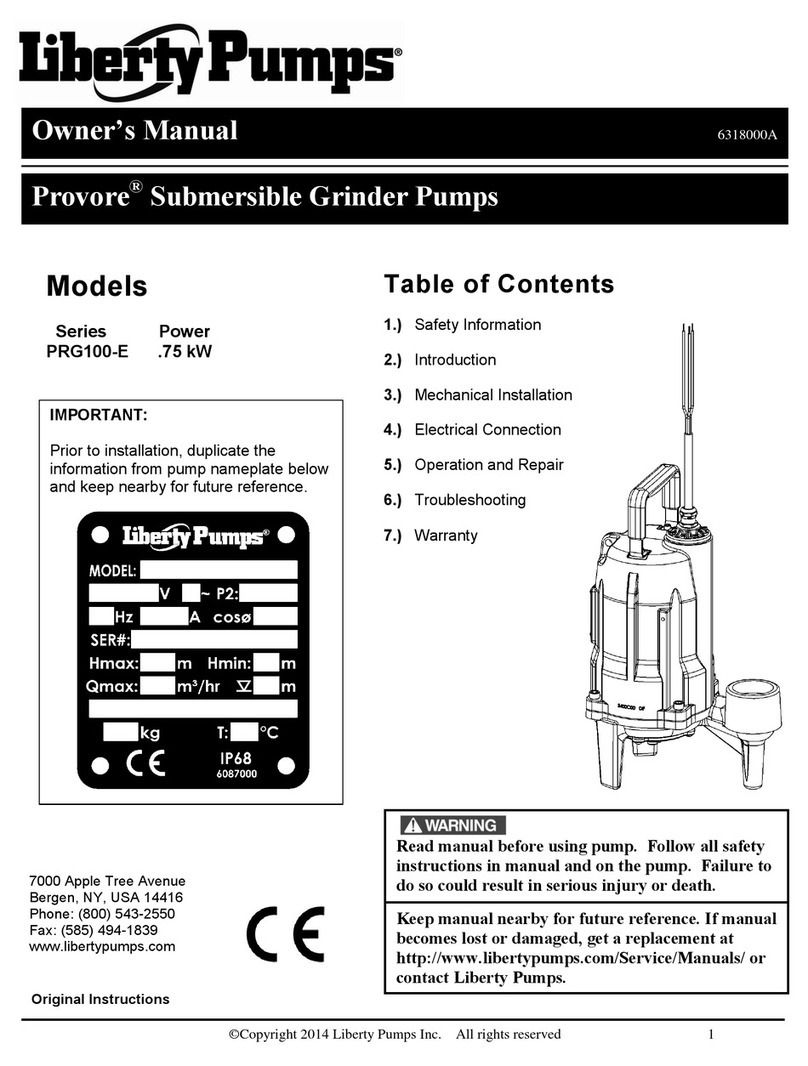
7034000N Copyright © Liberty Pumps, Inc. 2022
All rights reserved. 3 | EN
Do not use an extension cord to power the product. Extension
cords can overload both the product and extension cord
supply wires. Overloaded wires will get very hot and can catch
on fire.
This product requires a separate, properly fused and
grounded branch circuit, sized for the voltage and amperage
requirements of the pump, as noted on the nameplate.
Overloaded branch circuit wires will get very hot and can
catch on fire. When used, electrical outlets shall be simplex of
the appropriate rating.
For cord replacement: power cord must be of the same length
and type as originally installed on the Liberty Pumps product.
Use of incorrect cord may lead to exceeding the electrical
rating of the cord and could result in death, serious injury, or
other significant failure.
Do not use this product with or near flammable or explosive
fluids such as gasoline, fuel oil, kerosene, etc. If rotating
elements inside pump strike any foreign object, sparks may
occur. Sparks could ignite flammable liquids.
Sewage and effluent systems produce and may contain
flammable and explosive gases. Prevent introduction of
foreign objects into basin as sparks could ignite these gases.
Exercise caution using tools and do not use electronic devices
or have live, exposed electrical circuits in or around basins,
open covers and vents.
Manual pumps that have been factory constructed with a
power cord with no male attachment plug must use an
approved motor control panel. Do not wire a switch in series
with the pump power cord as this can overload the wires.
Overloaded wires get very hot and can catch on fire.
These pumps are not to be installed in locations classified as
hazardous in accordance with the National Electric Code®,
ANSI/NFPA 70.
Energizing the control panel or breaker for the first time is
potentially dangerous. Licensed electrical personnel should
be present when the panel or breaker is energized for the first
time. If faults caused by damage or poor installation practices
have not been detected, serious damage, injury or death can
result when power is applied.
Do not modify the pump/pump system in any way.
Modifications may affect seals, change the electrical loading
of the pump, or damage the pump and its components.
All pump/pump system installations shall be in compliance
with all applicable Federal, State, and Local codes and
ordinances.
Do not allow children to play with the pump system.
Do not allow any person who is unqualified to have contact
with this pump system. Any person who is unaware of the
dangers of this pump system, or has not read this manual, can
easily be injured by the pump system.
Keep clear of suction and discharge openings. To prevent
injury, never insert fingers into pump while it is connected to
a power source.
In 208/230V installations, one side of the line going to the
pump is always “hot”, whether the float switch is on or off. To
avoid hazards, install a double pole disconnect near the pump
installation.
Vent basin in accordance with local code. Proper venting of
sewer and effluent gases alleviates poisonous gas buildup
and reduces the risk of explosion and fire from these
flammable gases.
Wear adequate Personal Protective Equipment when working
on pumps or piping that have been exposed to wastewater.
Sump and sewage pumps often handle materials that can
transmit illness or disease upon contact with skin and other
tissues.
Do not enter a pump basin after it has been used. Sewage and
effluent can emit several gases that are poisonous.
Do not remove any tags or labels from the pump or its cord.
Do not use this product with flammable, explosive, or
corrosive fluids. Do not use in a flammable and/or explosive
atmosphere as serious injury or death could result.
This product contains chemicals known to the State of
California to cause cancer and birth defects or other
reproductive harm. www.p65warnings.ca.gov.
This pump has been evaluated for use with wastewater only.
For pressure sewer applications, verify a Redundant Check
Valve Assembly (curb stop and check valve) is installed
between the pump discharge and the street main, as close to
the public right-of-way as possible, on all installations to
protect from system pressures.
Verify 3-phase pumps for proper rotation prior to installing
pump(s) in basin. To change rotation, reverse any two of the
three power leads to the pump (not the ground). Code the
wires for reconnection after installation.
Do not dispose of materials such as paint thinner or other
chemicals down drains. Doing so could chemically attack and
damage pump system components and cause product
malfunction or failure.
Do not use pumps with fluid over 140°F (60°C). Operating the
pump in fluid above this temperature can overheat the pump,
resulting in pump failure.
Do not use pump system with mud, sand, cement,
hydrocarbons, grease, or chemicals. Pump and system
components can be damaged from these items causing
product malfunction or failure. Additionally, flooding can
occur if these items jam the impeller or piping.
Do not introduce any consumer item that is not toilet paper
into a non-grinder (dewatering/effluent or sewage) pump/
pump system. This includes, but is not limited to the
following: feminine products, wipes, towels, towelettes, dental
floss, swabs, pads, etc. Items such as these put the pump
under undo strain and can result in pump/pump system
failure. Additionally, it creates conditions for discharge line
blockage.
Submersible Pump—do not run dry.
RISK OF FIRE
RISK OF SERIOUS INJURY OR DEATH



















































